After nearly four years, we've finally hit halfway! And how fitting to celebrate with a cuisine that's a synthesis of several influences. Libya is a real culinary interface between Africa and the Mediterranean: stews over a ball of pounded dough definitely evoke many of the sub-Saharan meals we've had so far, while spice-heavy preparations of lamb have the influence of the Ottoman Empire all over them. There's even a little legacy of the Italian occupation. For being a cuisine you hear very little about, it was really, really good — and little known, to the extent that I could find only one site with more than a few Libyan recipes. (Though it was a great site that provided all the recipes!)
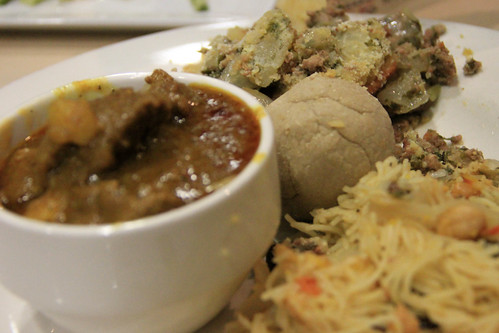
To mark the occasion, we decided to make a bigger occasion out of it, and the stars aligned — our local Whole Foods donated the food and connected us to the Oregon Culinary Institute, which provided a beautiful space and a chef and several students to make it all happen. Huge thanks to Leora at Whole Foods, and to Tera, Chef Maxine, and all the students who chopped, stirred, and (blessedly) cleaned for fifty people. I fret that the leftovers they took home was scant compensation for so many hours of work! They're in the far back of the photo here, but they deserve to be front and center!
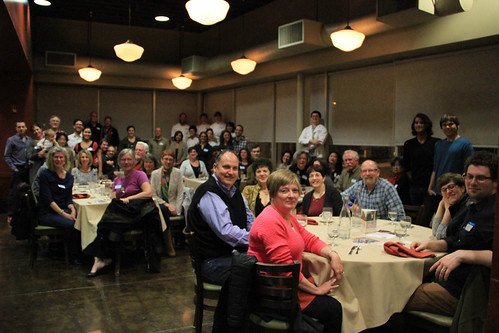
We passed one more milestone on this meal, crossing $25,000 in fundraising for charities addressing hunger around the world. For this one meal, we split the proceeds between Mercy Corps and Whole Planet Fountation — if you shopped at Whole Foods in March, you may still have one of those fetching purple-printed bags explaining how their microloans help families around the world.
Mseyer | Quick pickles | Recipe
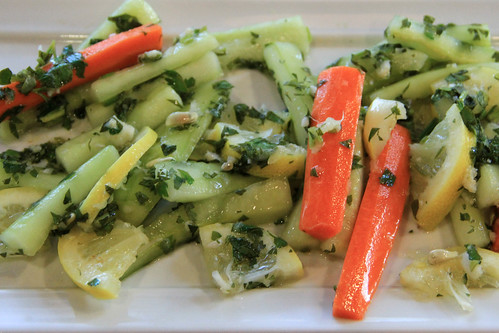
Simple to throw together, just cut some veggies into matchsticks and mix with a brine with the right balance of hot peppers. It's a vibrant texture and color contrast to the rest of the meal. Or you can do as we did, and just nibble on them as an appetizer.
Bazeen | Recipes: Dough and lamb stew; tomato soup
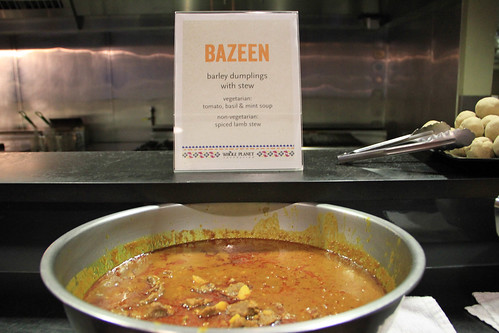
This dish centers around a lump of dough made mostly of barley. It's one of the stranger techniques I've seen, where you dump a whole lot of flour in a little bit of salted water but don't mix it for 45 minutes. The outside of course gets wet but the inside is dry. Then you mix it all up — thankfully, a stand mixer works great, otherwise it'd be a ton of tough stirring — and amazingly it all comes together into a mass that can be made into balls. This means of preparing starch is attributed to the Berbers, but its popularity has spread.
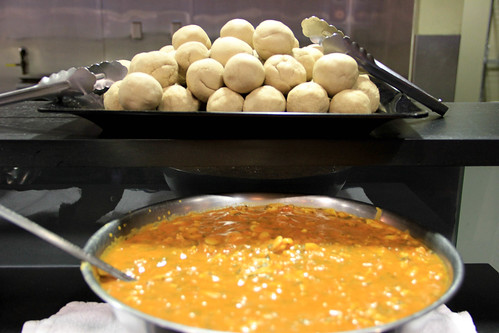
What's far tastier, to me and apparently most of the guests, is the stew that goes on top. The primary choice was a lamb stew with spices like turmeric and fenugreek with potato chunks and a little tomato sauce to redden it up. Nothing particularly fancy or more exotic than what you can find in a supermarket, but it was well-balanced and rich, a real crowd pleaser. For a vegetarian stew, I found a lovely soup of tomato with herbs like mint and basil, and followed a hunch from another recipe and used dried fava beans — no soaking, boiled on their own, then added to the soup — which turned out amazingly well. The flavor was more delicate, as you'd imagine with fresh herbs, and surprisingly full for a vegetarian sauce. (Check out the quantities we were cooking in!)
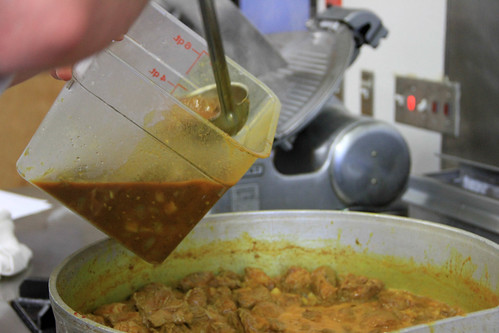
Due to serving logistics, we only had small cup-size soup bowls, so it was essentially impossible to eat the dough with the stew on top as would be traditional. If you're making this, you'll want to make an effort to get bigger stew bowls, or better yet serve it all in an enormous platter to be eaten directly with the hands.
Note that I anguished over whether to make a shorba libiya, the oft-proclaimed national dish, but in the end I figured it's pretty similar to the lamb stew that went with the bazeen, and the bazeen's so distinctive that I just had to do it!
Makaruna imbaukha | Steamed pasta with pumpkin and raisins | Recipe
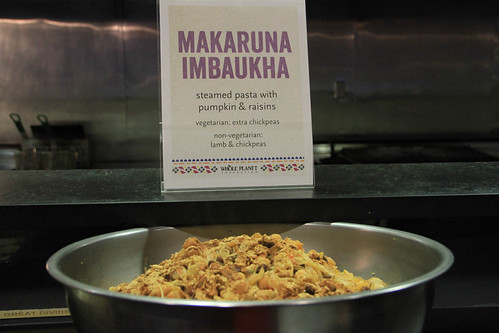
Couscous is traditionally made by steaming over the sauce with which it is to be served. But who knew you could prepare Italian-style pasta the same way? (Confession: due to issues of timing and logistics we ended up boiling the pasta the normal way, but I'd like to try it the traditional way someday!)

The sauce is also really intriguing. Not only are the base ingredients a sweet-savory blend of chickpeas, pumpkin, and raisins plus generous bay leaves, but the spices really take it over the top, with a generous dose of cinnamon, ground ginger, butter, and rosewater right before serving. I'm pretty sure nobody in the room had had pasta with quite that variety of seasonings before! The reviews were a bit mixed: some people were thrown for a loop by flavors they traditionally associate with dessert, while others found it intriguing and compelling.
Mbattan kusha | Potato and ground lamb casserole | Recipe
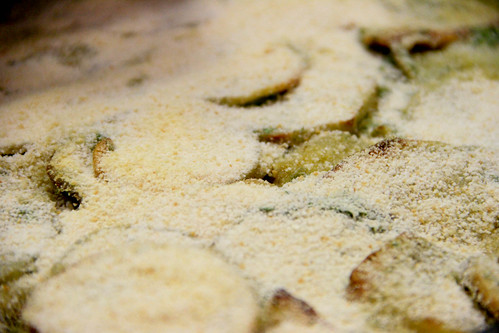
The more common, and certainly more distinctive, version of mbattan involves cutting a big notch out of a potato, stuffing it with seasoned meat, and deep-frying it. While that would have been fun, it would have been too complicated to pull off for serving to several dozen people at once, even in a commercial kitchen. So instead, we went with a deconstructed, oven-baked variant with layers of pre-roasted potato slices sandwiching a very ample ground-lamb filling. While this was probably the least exotic dish of the evening, it was perhaps the most popular, and rightly so: a great contrast of crunchy potato with soft meat, and a nicely balanced seasoning throughout.
Harissa | Spicy sauce | Recipe
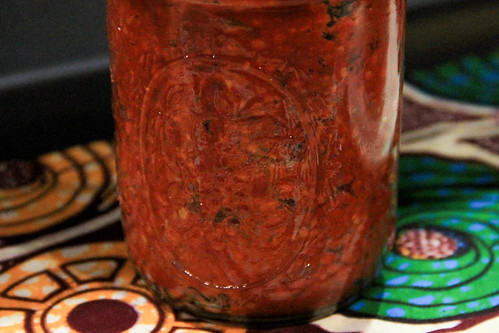
I didn't realize, until I tried to find them, that fresh red chili peppers are only available seasonally. Nowhere in town had them! So I went to my standby Asian market up on Killingsworth for two packages of frozen Thai peppers. (This coming summer I'll make a point of freezing the best red peppers I can find!)
Finding the peppers was the second-hardest part; the hardest was making sure not to get any bit of it in my eyes! Once I accomplished those two, it was as simple as a little chopping of the ancillary ingredients, a blender, and a bit of time on the stove. I thought I'd made too much, but it turns out I underprepared, because every last bit was gone before the meal was over.
Basbousa bil tamr | Semolina cake with date filling | Recipe
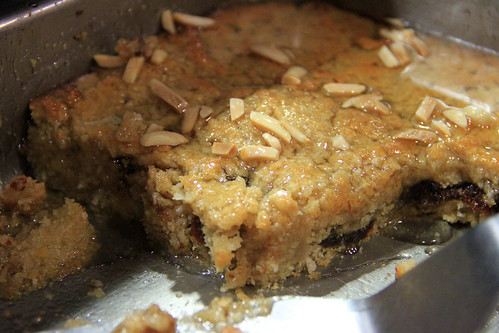
The general technique for making cakes in the Middle East and the kitchens it's influenced is quite a bit foreign to my Eurocentric sensibilities. Whereas the cakes I know tend to be fluffy with the sugar baked in, these cakes are instead dense and fairly unsweet until they're doused with syrup after baking. (That's why baklava's so darn sticky.) In fact, this batter, based around semolina and coconut, was so thick that I pressed rather than pouring it into the pan. It was also a challenge to put together, since there's a layer of date paste sandwiched between two layers of that semolina-coconut dough. (Protip: try rolling out the date paste between waxed paper or saran wrap, it'd be a whole lot messy than pressing sections between your hands like I did!) The baking went fine, though the cake was positively swimming in syrup and we had to pour much of it off, so you can safely make quite a bit less than the recipe calls for.
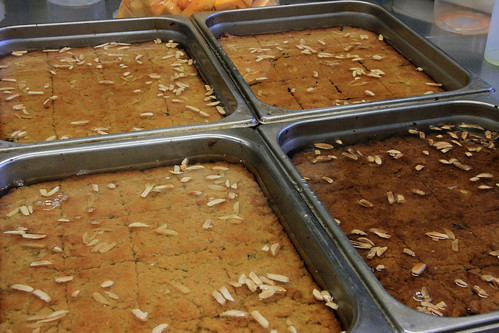
I found it pretty tasty, but I've grown to like this type of dense, cloying treat. It went really well with the recommended qashta cream — if you can find it it'll probably be in a can with the Puck brand name, but World Foods in Portland happens to carry a fresh version that goes under a name that escapes me but is a heavenly rich, medium-tangy accompaniment.
Thanks once again to Whole Foods and everyone at Oregon Culinary Institute. This was a really special evening, a fittingly collaborative way to celebrate going halfway around the world, one feast at a time!